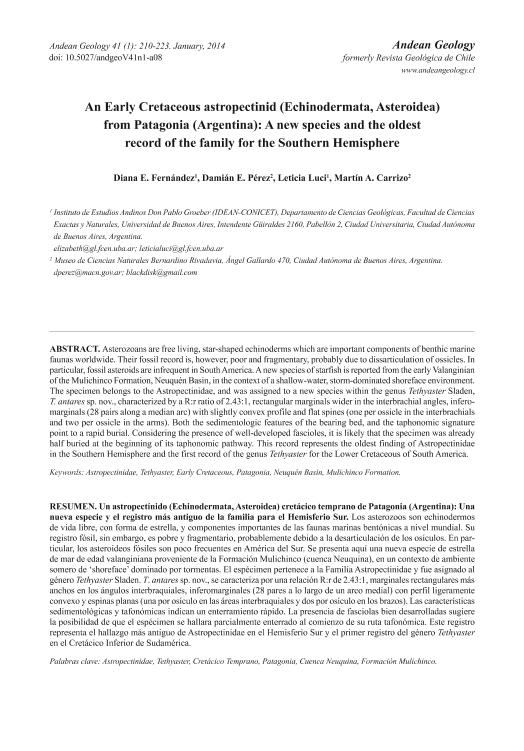Artículo
Los asterozoos son echinodermos de vida libre, con forma de estrella, y componentes importantes de las faunas marinas bentónicas a nivel mundial. Su registro fósil, sin embargo, es pobre y fragmentario, probablemente debido a la desarticulación de los osículos. En particular, los asteroideos fósiles son poco frecuentes en América del Sur. Se presenta aquí una nueva especie de estrella de mar de edad valanginiana proveniente de la Formación Mulichinco (cuenca Neuquina), en un contexto de ambiente somero de ‘shoreface’ dominado por tormentas. El espécimen pertenece a la Familia Astropectinidae y fue asignado al género Tethyaster Sladen. T. antares sp. nov., se caracteriza por una relación R:r de 2.43:1, marginales rectangulares más anchos en los ángulos interbraquiales, inferomarginales (28 pares a lo largo de un arco medial) con perfil ligeramente convexo y espinas planas (una por osículo en las áreas interbraquiales y dos por osículo en los brazos). Las características sedimentológicas y tafonómicas indican un enterramiento rápido. La presencia de fasciolas bien desarrolladas sugiere la posibilidad de que el espécimen se hallara parcialmente enterrado al comienzo de su ruta tafonómica. Este registro representa el hallazgo más antiguo de Astropectinidae en el Hemisferio Sur y el primer registro del género Tethyaster en el Cretácico Inferior de Sudamérica. Asterozoans are free living, star-shaped echinoderms which are important components of benthic marine faunas worldwide. Their fossil record is, however, poor and fragmentary, probably due to dissarticulation of ossicles. In particular, fossil asteroids are infrequent in South America. A new species of starfish is reported from the early Valanginian of the Mulichinco Formation, Neuquén Basin, in the context of a shallow-water, storm-dominated shoreface environment. The specimen belongs to the Astropectinidae, and was assigned to a new species within the genus Tethyaster Sladen, T. antares sp. nov., characterized by a R:r ratio of 2.43:1, rectangular marginals wider in the interbrachial angles, inferomarginals (28 pairs along a median arc) with slightly convex profile and flat spines (one per ossicle in the interbrachials and two per ossicle in the arms). Both the sedimentologic features of the bearing bed, and the taphonomic signature point to a rapid burial. Considering the presence of well-developed fascioles, it is likely that the specimen was already half buried at the beginning of its taphonomic pathway. This record represents the oldest finding of Astropectinidae in the Southern Hemisphere and the first record of the genus Tethyaster for the Lower Cretaceous of South America.
Un astropectínido (Echinodermata, Asteroidea) cretácico temprano de Patagonia (Argentina): una nueva especie y el registro más antiguo de la familia para el Hemisferio Sur
Título:
An Early Cretaceous astropectinid (Echinodermata, Asteroidea) from Patagonia (Argentina): a new species and the oldest record of the family for the Southern Hemisphere
Fecha de publicación:
01/2014
Editorial:
Servicio Nacional de Geología y Minería
Revista:
Andean Geology
ISSN:
0718-7092
e-ISSN:
0718-7106
Idioma:
Inglés
Tipo de recurso:
Artículo publicado
Clasificación temática:
Resumen
Archivos asociados
Licencia
Identificadores
Colecciones
Articulos(IDEAN)
Articulos de INSTITUTO DE ESTUDIOS ANDINOS "DON PABLO GROEBER"
Articulos de INSTITUTO DE ESTUDIOS ANDINOS "DON PABLO GROEBER"
Articulos(MACNBR)
Articulos de MUSEO ARG.DE CS.NAT "BERNARDINO RIVADAVIA"
Articulos de MUSEO ARG.DE CS.NAT "BERNARDINO RIVADAVIA"
Citación
Fernández, Diana Elizabeth; Perez, Damián; Luci, Leticia; Carrizo, Martin Alejandro; Un astropectínido (Echinodermata, Asteroidea) cretácico temprano de Patagonia (Argentina): una nueva especie y el registro más antiguo de la familia para el Hemisferio Sur; Servicio Nacional de Geología y Minería; Andean Geology; 41; 1; 1-2014; 210-223
Compartir
Altmétricas




